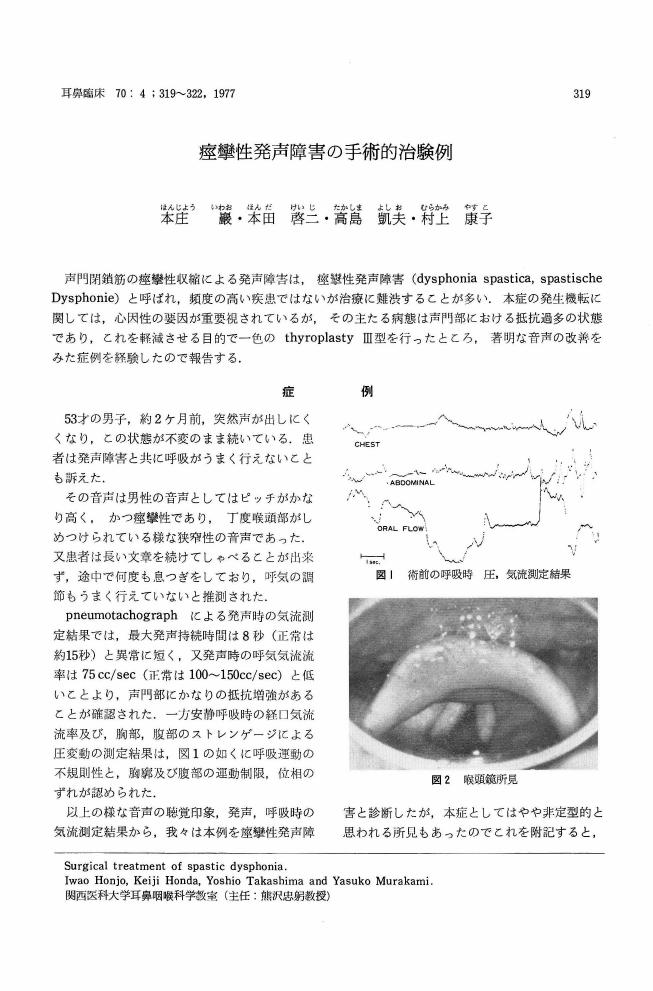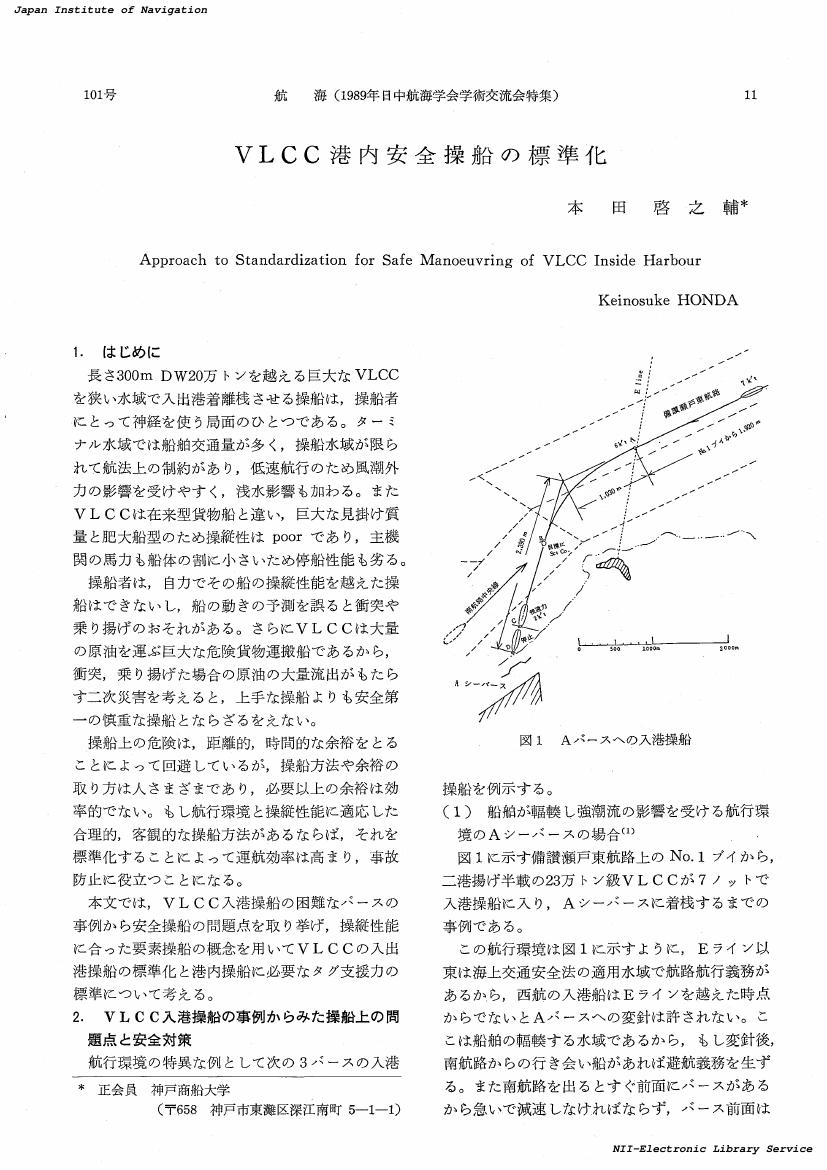3 0 0 0 強風下の双錨泊船の振れ回りと錨鎖張力に関する模型実験
- 著者
- 本田 啓之輔 小須田 敏
- 出版者
- 公益社団法人 日本航海学会
- 雑誌
- 日本航海学会論文集 (ISSN:03887405)
- 巻号頁・発行日
- vol.66, pp.145-152, 1982
In order to find a weak point for mooring, authors carried out the model experiments on the above title problem by using of 1/50 scale model of GT 5,000 ton cargo ship. The external force acting on the model ship in a water tank with generator is wind force, no wave. The wind-direction were changed at every 15 degrees from the line drawed vertically to a line between both anchors. Main experimental results are as follows; (1) A Open-moor of which the leg angle between both chain cables is about 60° is more safety because of smaller yawing motion, as that being obtained by YONEDA. However, it should be taken notice that the shock load acting on the riding cable is greater than that at a single anchor, if the wind-direction is agreed with each cable line, and also that the most possibly raises a dragging anchor in such case. (2) Using Engine-astern in order to control the yawing motion at anchor has the effect of checking gently and smaller, as that being obtained by T.S.HOKUTO-Maru. However, such engine motion at anchor under heavy weather will be brought on the dragging anchor owing to the shortage of an anchor-holding power.
1 0 0 0 OA さまざまな視点からみた「視点」
1 0 0 0 OA 痙攣性発声障害の手術的治験例
1 0 0 0 OA 耳管機能の裏付け
- 著者
- 熊沢 忠躬 本田 啓二
- 出版者
- 耳鼻咽喉科臨床学会
- 雑誌
- 耳鼻咽喉科臨床 (ISSN:00326313)
- 巻号頁・発行日
- vol.75, no.9, pp.1755-1766, 1982-09-01 (Released:2011-11-04)
- 参考文献数
- 18
An honorable presentation entitled “Clinical and Fundamental Studies on the Eustachian Tube” was reported at the annual meeting of Japan Society of Otolaryngology in 1980. In this presentation, the function of the Eustachian tube was discussed fundamentally and clinically, although we found that various clinical problems still remain in our practice on this tube.The following points should be considered;1) Are Eustachian tube problems functional or organic?2) The location of the lesion.3) Patency.4) Reversibility of dysfunction.5) Clearance function of fluid and air through the tube.6) Relationship between this tube and peritubal lesion in the pharyngeal ostium, tympanal ostium, parotid gland and submaxillar joint.7) Choice of therapeutic methods and evaluation of the result.When these problems are solved, the diagnosis of the Eustachian tube function will be made clearly. Tubo-tympanoaerodynamic graphy, tympanometry, cndoscopic and electromyographic findings will be useful for this purpose. Physical and anatomical research should also be performed.
1 0 0 0 IR 多読性に由来する漢字の曖昧性と送り仮名の語彙的明確化機能
- 著者
- 本田 啓輔 Honda Keisuke
- 出版者
- 筑波大学一般応用言語学研究室
- 雑誌
- 言語学論叢 (ISSN:0914966X)
- 巻号頁・発行日
- no.26, pp.17-42, 2007-12-31
1 0 0 0 OA VLCC港内安全操船の標準化(<特集>1989年日中航海学会学術交流会)
- 著者
- 本田 啓之輔
- 出版者
- 公益社団法人 日本航海学会
- 雑誌
- 航海 (ISSN:24331198)
- 巻号頁・発行日
- vol.101, pp.11-17, 1989-09-25 (Released:2017-07-12)
1 0 0 0 接岸避泊に関する模型実験
- 著者
- 本田 啓之輔 松木 哲 井上 欣三
- 出版者
- 公益社団法人 日本航海学会
- 雑誌
- 日本航海学会論文集 (ISSN:03887405)
- 巻号頁・発行日
- vol.57, pp.107-118, 1977
In order to find more safety and more suitable mooring system of a moored ship to a quay by means of mooring lines and fenders in a harbour under the heavy weather such as typhoon, authors carried out a series of experiment by using of 1/50 scale models in the water-tank equipment and recorded time histories on the tension load of mooring lines, the impact force against fenders and the ship's motion with six degrees of freedom, in oblique, head and beam seas to the quay wall. We considered the case of GT 5, 000t cargo ship (Lpp=115m) moored to the quay by eight ideal mooring arrangements at 14m in the depth of water rising up to the top of quay wall. The wave condition acting on the ship were extensively changed with regard to the wave length, wave height and attack angle of wave to the quay. In addition to these experiments, we carried out another series of the model experiment for a dolphin-ship mooring in order to realize the validity of the theorical computation by the linearized numerical model of a mooring system which was developed by Japan Ship Research Association.
1 0 0 0 前後2点ブイ係留避泊に関する模型実験
- 著者
- 本田 啓之輔 松木 哲 井上 欣三
- 出版者
- 公益社団法人 日本航海学会
- 雑誌
- 日本航海学会論文集 (ISSN:03887405)
- 巻号頁・発行日
- vol.59, pp.119-134, 1978
Authors carried out the model experiment for two buoys-mooring system, in the case of GT 5,000t cargo ship, in order to find the critical wave conditions which exist for safe buoy mooring in the harbour under the heavy weather. The wave condition acting on the ship were extensively changed regard to the wave length, wave height and the attack angle of wave to the fore and after buoys center line. As main results for the model experiment in regular wave, it is emphasised that the most important factors affecting the tension of buoy's mooring lines are the drifting force due to the wave than the amplitudes of the periodic ship's motions with six degrees of freedom, and that the critical height of waves for safe buoys mooring may be given 0.8m in the full draft condition and 1.0m in the half draft condition in beam seas to the ship. In addition to these experiment, the simulation for the ship's motion and mooring force were carried out by the linearized numerical model of the multiple buoys mooring system which was developed by the Japan Ship Rerearch Association.


